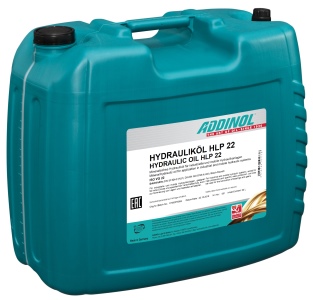


HLP 22 from ADDINOL
Hydraulic oils with the designation HLP 22 are used as pressure fluids in industrial and mobile plants. They absorb high pressure (over 200 bar), protect against wear and thus prevent premature material ageing.
The designation HLP 22 is based on the letter combination "HLP" and "22". The DIN 51524-2 standard defines the properties of hydraulic oils with HLP. These are hydraulic oils with anti-ageing and anti-corrosion additives as well as active agents for reducing friction and wear. The number 22 describes the kinematic viscosity of the hydraulic oil (in mm²/s) at 40 °C. The respective viscosity classes were defined in ISO VG.
Our HLP 22 hydraulic oils
ADDINOL HYDRAULIC OIL HLP 22
Specifications / Approvals:
DIN 51524-2 (HLP), DIN 51519, ISO 3448, DIN EN ISO 6743-4 (HM)
meets the requirements:
Bosch-Rexroth
ADDINOL FOODPROOF HLP 22 S
Specifications / Approvals:
NSF H1, DIN 51524-2 (HLP), Kosher, Halal
HLP 22 viscosity
The viscosity of HLP 22 is based on the defined viscosity class of ISO VG (International Organization for Standardization Viscosity Grade). This stipulates that the kinematic viscosity of the hydraulic oil must level off between 19.8 and 24.2 mm²/s at 40 °C. The center point viscosity is 22 mm²/s. Oils with ISO VG 22 are to be regarded as quite thin liquid and almost aqueous. The ISO VG classes range from 2 (very thin) to 1500 (high viscous).
What is the difference between HLP 22 and HLP 46?
Hydraulic oils of class HLP 22 are primarily less viscous than hydraulic oils of class HLP 46. This is due to the ISO VG classes to which the oils belong. While the centre point viscosity of HLP 22 is 22 mm²/s, it is 46 mm²/s for HLP 46. With increasing value, the viscosity of the oils increases.
In addition, oils with HLP 22 have a better pour point than HLP 46 and therefore have better flow properties at cold temperatures. On the other hand, the oils with HLP 46 have a higher flash point and are therefore more heat-resistant than HLP 22.
Which oil is suitable for your hydraulics depends on the application and the manufacturer's specifications. If you are unsure which hydraulic oil to use, our application technology experts will be happy to help you.
Can HLP 22 and HLP 46 oils be mixed?
You can mix hydraulic oils of classes HLP 22 and HLP 46 with each other. The oils will form a homogeneous mass and will not separate. However, this also changes the oil properties of both oils. Therefore, we advise against mixing. If the properties of the mixed oils no longer match the manufacturer's specifications for your hydraulics, increased wear or, in the worst case, system failure may occur. Always fill only the oil of one class into your system and, if in doubt, change the oil completely instead of adding unsuitable hydraulic oil. In most cases, the manufacturer specifies the viscosity class the lubricating oil must have for the application.


